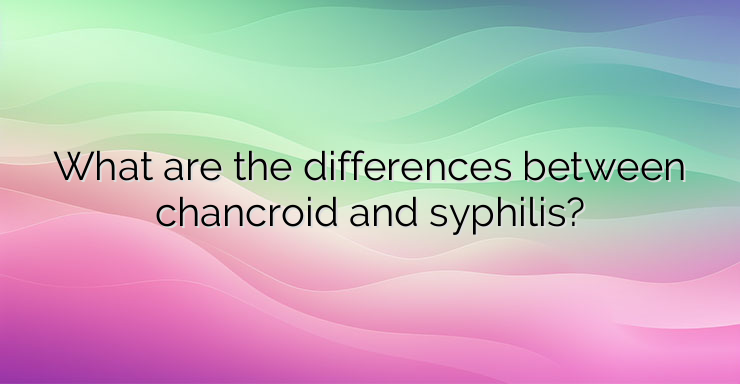What is chancroid? Chancroid or soft chancre (ulcus venericum) is an acute and highly contagious sexually transmitted infectious disease that causes genital ulcers. The causative agent of chancroid is Haemophilus ducreyi, a gram-negative streptobacillus with the shape of a short rod with rounded ends. The bacillus penetrates the body through a broken mucosal barrier and causes an inflammatory reaction. Although rare in Europe, chancroid is relatively common in some parts of the developing world. As with syphilis, open sores caused by chancroid increase the risk of contracting other sexually transmitted infections, such as HIV. What are the symptoms of chancroid? Chancroid is often confused with syphilis in the early stages. Typically, the initial presentation of the condition is a red bump on the genitals or rectum that quickly turns into a pus-filled blister, usually within 4 to 10 days of exposure to the pathogen. The blister often bursts and forms a deep ulcer with well-defined borders. Unlike syphilis, these sores usually grow to larger sizes (several centimeters) and can be extremely painful. In contrast, a syphilis sore called a hard chancre (ulcus durum) is usually painless. The base of a chancroid ulcer may bleed easily if scratched or rubbed. Chancroid can also cause swelling, tenderness, and inflammation of the lymph nodes in the groin. The swelling can sometimes be so severe that it causes the abscess to burst, causing the accumulated pus to flow out, which is also not characteristic of syphilis. Men with chancroid usually develop a single ulcer, while women may develop multiple. Women may also experience dysuria (pain when urinating), while men usually do not suffer from this symptom. Untreated chancroid ulcers can persist for up to three months and cause significant scarring. How does chancroid differ from syphilis? Chancroid Sores usually develop within 10 days of exposure to the bacillus; Ulcers can grow up to 5 cm (as small as a coin); Ulcers are very painful; The bottom of the ulcers is uneven and covered with purulent plaque; About 50% of people develop swollen lymph nodes in the groin Syphilis The sores usually develop within 21 days of exposure to the pathogen; Ulcers are usually smaller than 2.5 cm; Ulcers are usually painless; Swollen lymph nodes are rare What are the causes of chancroid? Chancroid is caused by a gram-negative bacterium called Haemophilus ducreyi. In the initial period of the disease, the bacilli are mainly located extracellularly, and in the later stages – intracellularly. The infection is highly contagious and easily transmitted during sexual intercourse, however, for infection to occur there must be some disruption of the integrity of the stratum corneum of the skin or the covering epithelium of the mucous membrane. Bacteria can also pass through small tears in the skin,called microabrasions that occur during intercourse. Additionally, a person can spread the infection from their genitals to other parts of their own body by touching a wound and then touching their eye or other parts of the skin. This is called autoinoculation. Chancroid is relatively rare in Europe and North America, although sporadic local outbreaks are known to occur. Globally, chancroid is the most common cause of genital ulceration, particularly in resource-poor parts of Africa and the Caribbean. Chancroid can increase the risk of HIV by allowing the virus easier access to the body, as well as by attracting to the site of infection more CD4 + T cells, which HIV attacks. These factors contribute in part to the high rate of HIV transmission in developing countries where chancroid and HIV are widespread. How is chancroid diagnosed? No laboratory test can immediately confirm a diagnosis of chancroid. There are also no approved tests available to accurately detect Haemophilus ducreyi. Although there are special tests for culturing (growing) Haemophilus ducreyi in a laboratory setting (by taking a swab sample of fluid from a wound), they are difficult to find and are less than 80% accurate. Some laboratories around the world have developed their own nucleic acid amplification-based assays (NAATs) to help diagnose chancroid. However, in the majority of cases, chancroid is diagnosed based on the characteristics of the disease and the exclusion of other diseases that cause genital ulcers. According to the Centers for Disease Control and Prevention (CDC), a probable diagnosis of chancroid can be made if the following four criteria are met: The person has one or more genital ulcers; Ulceration and swelling of the lymph nodes are consistent with chancroid; No evidence of syphilis based on laboratory tests; No laboratory evidence of genital herpes, a much more common disease affecting the genitals What is the treatment for chancroid? As a bacterial infection, chancroid is treated with antibiotics. There are four treatment regimens recommended by the CDC, in which antibiotics are given either orally (by mouth) or intramuscularly (by injection into a large muscle). Each dose is measured in grams (g) or milligrams (mg): Azithromycin – 1 g, oral, single dose; Ceftriaxone – 250 mg, intramuscular, single dose; Ciprofloxacin – 50 mg, twice daily, orally, for 3 days; Erythromycin – 500 mg, three times a day, orally, 7 days For reasons that are not fully understood, uncircumcised men and people with HIV sometimes respond less well to therapy and may need to be re-treated. For this reason, follow-up examinations should be performed three to seven days after completion of therapy. For most people, symptoms begin to improve within this time period.Anyone suspected of having chancroid should also be tested for HIV. References: 1. Gonzalez-Beira C, Marks M, Chen CY, Roberts S, Mitja O. Epidemiology of Haemophilus ducreyi infections 2. Lautenschlager S, Kemp M, Christensen JJ, Mayans MV, Moi H. 2017 European guideline for the management of chancroid 3. Roett MA. Genital ulcers: differential diagnosis and management 4. Centers for Disease Control and Prevention. Chancroid


Leave a Reply